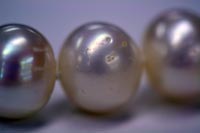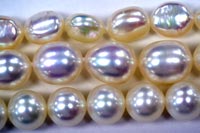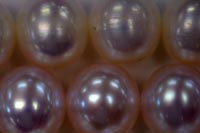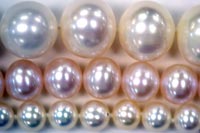SERIES 1: How to Shop for Pearls
Part 3 – Main Quality Factors for Any Pearl Type
Once I am confident I have genuine pearls in front of me, the main important factors (simplified) that determine a pearl’s quality are the luster and blemishing. Shape should be included if you are looking for round pearls. There are other important factors like size, matching, nacre, and color when grading pearls professionally; but for the individual consumer these factors usually come down to a matter of personal preference. And even with luster and blemishing, which is more important in a pearl is your own preference. Personally, luster is always the deciding factor for me.
I think a pearl with amazing luster and a few blemishes is more attractive than a perfectly clean pearl with poor luster, but to each his own.
Blemishing really needs no explanation. A blemish on a pearl can be anything from a miniscule pinprick dent, to a white spot that is flush with the surface, to large deep inclusions that are 1mm or more in size. Obviously the less and/or smaller the blemishes, the better. I like to judge blemishing based on if I can see the blemishes from 12″-18″ away while the pearls are being worn. If not, then 90% of people that see the piece on me would not be close enough to see the blemishes either.
Luster is a little bit more tricky as it takes awhile to determine luster on an individual strand or pearl without much to compare it to. Often, even pearl buyers (who have seen many, many pearls) will take a strand of pearls with the best luster they have, to compare with the pearls they are buying. This because even comparing luster among a bunch of pearls/strands is relative to the range of luster that the give selection has. This gives them the assurance that they are getting at least the same quality of luster they are used to, and not just picking the most lustrous strands from whatever selection the pearl farmer is showing.
Light can make a big difference in how the luster appears. In bright, direct light, all pearls will look shiny; differentiating luster quality is next to impossible. Fluorescent light can also be very hard to accurately see luster in. Beware, because often jewelry stores show their pearls under direct fluorescent light, making them all appear very reflective. Always have the pearls taken out of any cases or lights to inspect luster quality. In indirect light, pearls with poor luster will have a chalky or dull appearance. A pearl with excellent luster will have a very crisp reflection. A trick to telling if it is high luster is to look at the light source reflecting in the surface.
Do the edges of the light look soft and hazy? Or can you clearly see the crisp edges and details of the light? With high luster, you should be able to easily see clear details in the reflection, like your facial features. Notice how much shinier and clearer the light source is in the pearls in the bottom row of the picture. Being able to accurately determine luster with no comparison will take some time, but you can always use whatever pearls you already have to at least make sure your next pearls have equal or better luster.
If you’re buying round pearls, then obviously the rounder the better. Except!….when it comes to luster and blemishing. A very round pearl with poor luster or heavy blemishing is less desired than a near-round pearl with high luster and/or little blemishing. Generally you’ll find the best looking pearls for your budget, if you’re flexible on some of the factors. If you narrow your search to only the roundest freshwater pearls or only pearls with no blemishing, you’ll instantly dismiss a lot of pearls that in actuality might look better overall considering all or most other factors.
**I’d love to hear questions or comments from others who have bought or are looking at pearls. What do you find most desirable in the pearls you’re looking at?




